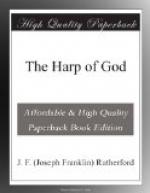[230]Jesus likened his humanity to bread. He said: “I am the bread of life.... This is the bread which cometh down from heaven, that a man may eat thereof, and not die.... For my flesh is meat indeed, and my blood is drink indeed.... As the living Father sent me, and I live by the Father: so he that eateth me, even he shall live by me.” (John 6:48,50,55,57) By this we understand that Jesus gave up his human life in order that the value thereof might be presented to divine justice in heaven as the great ransom-price. To eat means to appropriate to oneself. Then it follows that any one who accepts or appropriates to himself the value of Jesus’ sacrifice by believing on the Lord Jesus Christ and doing the Father’s will, that one will have life everlasting through Christ Jesus. The apostle Paul makes it clear that the death of Jesus was for the benefit of the entire human race when he says: ‘Jesus, ... by the grace of God, tasted death for every man’. “There is one God, and one mediator between God and men, the man Christ Jesus; who gave himself a ransom for all, to be testified in due time.”—Hebrews 2;9; 1 Timothy 2:5,6.
[231]"Sin is the transgression of the law.” (1 John 3:4) “The wages of sin is death.” (Romans 6:23) Adam transgressed the divine law and for this reason suffered the penalty of death, and this penalty came upon all mankind by inheritance. Jesus the perfect man permitted his life to be taken that it might be used for the purpose of releasing Adam and his offspring from the great enemy death, and that they might have a full opportunity for life. Hence his life was made an offering for sin, or a sin-offering.
[232]For many centuries Jehovah foreshadowed this great event in his plan, and this adds to the importance of it; in fact, without the sacrifice of Jesus it would have been impossible for any of the human race ever to live at all.
[233]Looking back, then, at the picture that Jehovah made by the use of the Jewish people and their ceremonies, we see that the bullock slain on the atonement day pictured Jesus the perfect man at the age of thirty years. The court surrounding the tabernacle was a picture of perfect humanity. Therefore the bullock slain in the court foreshadowed or pictured the fact that the perfect man Jesus died in that condition on earth as a perfect man. By his death he provided the ransom-price. He did this to carry out the Father’s plan.
[234]In the picture, the slaying of the bullock was the beginning of the sin-offering. After the bullock was slain its blood was put into a vessel and the high priest carried it in this vessel, ultimately reaching the Most Holy, where it was sprinkled, as above mentioned. The high priest in the Holy pictured Jesus during the three and one-half years of his sacrificial ministry; and the high priest’s appearance in the Most Holy pictures Jesus the high priest, resurrected to the divine nature, appearing in heaven itself in the presence of God, there to present the merit of his sacrifice as the sin-offering on behalf of mankind.—Hebrews 9:24.




